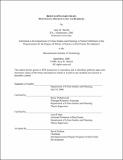| dc.contributor.advisor | Henry Pollakowski and Lynn Fisher. | en_US |
| dc.contributor.author | Merritt, Amy W | en_US |
| dc.contributor.other | Massachusetts Institute of Technology. Dept. of Urban Studies and Planning. | en_US |
| dc.date.accessioned | 2007-06-27T20:25:35Z | |
| dc.date.available | 2007-06-27T20:25:35Z | |
| dc.date.copyright | 2006 | en_US |
| dc.date.issued | 2006 | en_US |
| dc.identifier.uri | http://dspace.mit.edu/handle/1721.1/37428 | en_US |
| dc.identifier.uri | http://hdl.handle.net/1721.1/37428 | |
| dc.description | Thesis (S.M.)--Massachusetts Institute of Technology, Dept. of Urban Studies and Planning, 2006. | en_US |
| dc.description | This electronic version was submitted by the student author. The certified thesis is available in the Institute Archives and Special Collections. | en_US |
| dc.description | Includes bibliographical references (leaves 61-62). | en_US |
| dc.description.abstract | The study of greyfields for this thesis was motivated by the increasing problems of traffic and air pollution associated with sprawling development patterns. Typically located in inner ring suburban areas, greyfields, or failed retail malls, represent sites that can be redeveloped profitably into mixed-use, walkable neighborhoods. Yet, few successful examples of greyfield redevelopment exist, especially when compared to the relative proliferation of brownfield redevelopment. Brownfields, or contaminated urban sites, are very costly to remediate and it is surprising that this type of redevelopment outpaces greyfield redevelopment on such a significant scale. This thesis addresses the disparity between the two redevelopment types and describes differences between brownfields and greyfields through application of an economic model for redevelopment. The variables of the model are then applied to each redevelopment type and considered in the context of several greyfield case studies located on the east coast. | en_US |
| dc.description.abstract | (cont.) Where the economic model is incomplete in fully explaining the disparity between the redevelopment types, factors outside of the model have been considered, including the existence of externalities and public subsidies at federal, state and local levels. Lastly, suggestions of how to foster increased implementation of greyfield redevelopment and create an industry around the reuse of greyfield sites are discussed. | en_US |
| dc.description.statementofresponsibility | by Amy W. Merritt. | en_US |
| dc.format.extent | 62 leaves | en_US |
| dc.language.iso | eng | en_US |
| dc.publisher | Massachusetts Institute of Technology | en_US |
| dc.rights | M.I.T. theses are protected by copyright. They may be viewed from this source for any purpose, but reproduction or distribution in any format is prohibited without written permission. See provided URL for inquiries about permission. | en_US |
| dc.rights.uri | http://dspace.mit.edu/handle/1721.1/37428 | en_US |
| dc.rights.uri | http://dspace.mit.edu/handle/1721.1/7582 | |
| dc.subject | Urban Studies and Planning. | en_US |
| dc.title | Redeveloping greyfields : definitions, opportunities and barriers | en_US |
| dc.type | Thesis | en_US |
| dc.description.degree | S.M. | en_US |
| dc.contributor.department | Massachusetts Institute of Technology. Department of Urban Studies and Planning | |
| dc.identifier.oclc | 123195867 | en_US |
